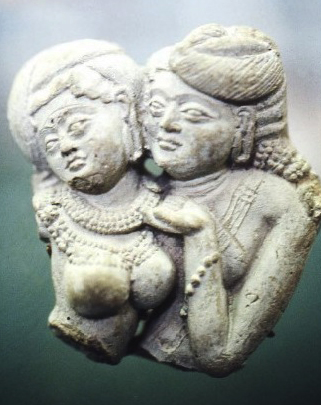ចម្លាក់មិថុន (Mithuna) សំដៅលើរូបមនុស្សប្រុសនិងមនុស្សស្រីក្នុងទម្រង់សាសងស្នេហាគ្នា ដែលគេតាក់តែងឡើងនៅក្នុងគម្ពីររបស់ព្រហ្មញ្ញសាសនា។ ទម្រង់ចម្លាក់នេះ បង្ហាញអំពីគំនិតដែលបង្ហាញឱ្យឃើញពីរឿងភោគផលដ្បិតមនុស្សប្រុស និងមនុស្សស្រីតែងតែជាគូនឹងគ្នាមិនអាចខ្វះបានសម្រាប់បង្កើតភោគផល។ ចម្លាក់មិថុន (Mithuna) គេប្រទះឃើញដំបូងនៅសម័យសុន្គ (Sunga) នៅរវាងស.វ.ទី២មុនគ្រឹស្តសករាជ ហើយមានការនិយមខ្លាំងជាបន្តបន្ទាប់នៅក្នុងសិល្បៈឥណ្ឌា។ មិថុន (Mithuna) មានលក្ខណៈខុសគ្នាខ្លាំងពីចម្លាក់ឥណ្ឌា ដោយម្យ៉ាងទៀតគេហៅថា “មៃថុន” (Maithuna) ដ្បិតចម្លាក់មៃថុនគេសំដៅទៅលើចម្លាក់ដែលបង្ហាញពីភាពស្រើបស្រាលរវាងមនុស្សប្រុស និងមនុស្សស្រីក្នុងការរួមភេទ ដូចមានបង្ហាញឡើងនៅលើចម្លាក់នៅប្រាសាទកាមសូត្រ (Kamasūtra) និងប្រាសាទជាច្រើនទៀតនៅស្រុកឥណ្ឌា ដែលចម្លាក់ភាគច្រើនទាក់ទងនឹងការរួមភេទ។
នៅក្នុងសិល្បៈខ្មែរ ចម្លាក់មិថុន (Mithuna) ពុំសូវសម្បូណ៌ឡើយ ពោល គឺមានតិចតួចណាស់នៅសម័យដំបូងៗរបស់ខ្មែរ ដែលជាការទទួលឥទ្ធិពលពីឥណ្ឌាដូចចម្លាក់ផ្សេងៗទៀតដូចគ្នាដែរ។ ប៉ុន្តែចម្លាក់មៃថុន មិនមានឆ្លាក់ឡើយនៅក្នុងសិល្បៈខ្មែរ ដែលទំនងមកពីចម្លាក់នេះមានភាពស្រើបស្រាលពេក ខ្មែរបុរាណមិនហ៊ានទទួលយក។
គេបានប្រទះឃើញចម្លាក់មិថុន (Mithuna) ដំបូងនៅអូរកែវ ដែលធ្វើអំពីដុត និងសព្វថ្ងៃរក្សាទុកនៅសារមន្ទីរខេត្តអានយ៉ាង ប្រទេសវៀតណាម (រូបលេខ៤)។ ចម្លាក់នេះឆ្លាក់នៅក្នុងក្បាច់រាងដូចក្រចកសេះ ដែលគេហៅថា “គូឌុ” បង្ហាញអំពីមនុស្សប្រុសនិងមនុស្សស្រីត្រឹមពាក់កណ្តាលខ្លួន ដែលខាងប្រុសយកដៃម្ខាងទ្រដើមទ្រូងមនុស្សស្រី។ ចម្លាក់ដីដុតនេះ អាចស្ថិតនៅក្នុងសម័យហ្វូណន រវាងស.វ.ទី៣ដល់ទី៥ នៃគ្រឹស្តសករាជ ប្រហាក់ប្រហែលនឹងចម្លាក់គូឌុធ្វើអំពីដីដុតផ្សេងទៀតដែលអ្នកស្រាវជ្រាវ Louis Malleret រកឃើញដែរ។
ចម្លាក់មិថុនមួយទៀតដែលយើងគិតថាសំខាន់នោះ គឺរកឃើញនៅផ្នែកកំពូលនៃប្រាសាទយាយព័ន្ធ តួប៉មកណ្តាល S1 (រូបលេខ៥) ដែលជាចម្លាក់នៅលើឥដ្ឋ បង្ហាញពីរូបមនុស្សប្រុសម្នាក់យកដៃម្ខាងឱបពីក្រោយមនុស្សស្រីម្នាក់ត្រឹមស្មា ហើយរូបនេះគេបង្ហាញត្រឹមមួយកំណាត់ខ្លួនដូចរូបឆ្លាក់ពីដីដុតរកឃើញនៅកំពង់ផែអូរកែវដែរ។ នៅក្នុងការសិក្សារបស់លោក Victorio Roveda លោកមិនបានលម្អិតអំពីចម្លាក់នេះឡើយ ដោយគ្រាន់តែសន្និដ្ឋាន ទំនងជាគូស្នេហ៍ ឬអាចមនុស្សប្រុសកំពុងធ្វើបានមនុស្សស្រី។
ចម្លាក់មៃថុនចុងក្រោយដែលរកឃើញនៅសិល្បៈខ្មែរ យើងប្រទះឃើញនៅផ្នែកខាងលើប្រាសាទភ្នំបាយ៉ង់ ដែលជាប្រាសាទសាងសង់នៅស.វ.ទី៧ ប្រហាក់ប្រហែលប្រាសាទយាយព័ន្ធដែរ។ ប៉ុន្តែចម្លាក់ដែលយើងឃើញ គឺបង្ហាញពីមនុស្សប្រុសនិងមនុស្សស្រីដេកក្បែរគ្នា ហើយដាក់ក្បាលទៅទិសផ្សេងគ្នាទៀតផង (រូបលេខ៦)។
ជារួមមក ការបង្ហាញចម្លាក់មៃថុននៅក្នុងសិល្បៈខ្មែរ ចំនួន ៣ ខាងលើនេះ គ្រាន់តែចង់បង្ហាញថា ឥទ្ធិពលឥណ្ឌាមកលើសង្គមខ្មែរនៅពេលនោះមានទំហំខ្លាំងក្លាណាស់ ម្ល៉ោះហើយ គំនិតនៃចម្លាក់ភោគផលដែលឥណ្ឌាមាន ខ្មែរក៏បានយកមកឆ្លាក់នៅលើសំណង់ប្រាសាទខ្មែរដូចគ្នាដែរ។
——————————————————
Mithuna sculpture in the early Khmer art
The statue of Mithuna (Mithuna) refers to a man and a woman in the form of loving, which is recorded in the scriptures of Brahmanism. This sculptural form represents the concept of making sexual, as men and women are always indispensable for each other. The Mithuna was first discovered during the Sunga period, between the 2nd century BC, and became increasingly popular in Indian art.
Mithuna is very different from the Indian sculpture, also called “Maithuna” because it refers to the sculpture that shows the arousal between men and women in sex. For instance, the sculpture at Kamasūtra and many other temples in India, most of them are related to sexual activities.
In Khmer art, the sculpture of Mithuna was not very abundant, that is, it was very rare in the early Khmer period, which was influenced by India like other sculptures as well. But Maithuna sculpture is not carved in Khmer art, which is likely because this sculpture is too erotic, the ancient Khmer did not dare to accept.
The first Mithuna sculpture was found in Okeo, and is now housed in the An Giang Provincial Museum in Vietnam. This sculpture, carved in the shape of a horse nail called “Kudu”, depicts a man and a woman with a haft body, with the male holding one hand holding the woman’s breast. This terracotta sculpture may have been in the Funan period between the 3rd and 5th centuries, similar to other Kudu statues found by archaeologist Louis Malleret.
Another Mithuna sculpture that we think is important and is found at the top of the Yeay Poan temple, the central tower S1, which is a sculpture on the brick wall showing a man holding a hand behind a woman, and this figure are shown only part of the body, like the carved image from the earthware found in the port of OKeo. In Victorio Roveda’s study, he did not elaborate on the sculpture, only speculating that it was likely a couple or maybe a man was abusing a woman.
The last Maithuna sculpture found in Khmer art is found at the top of Phnom Bayong Temple, a temple built in the 7th century, similar to Yeay Poan Temple. But the sculptures show men and women lying next to each other and with their heads in different directions.
Overall, the display of Maithuna sculptures in the above three in Khmer arts just wanted to show that India’s influence on Cambodian society at that time was so great that the concept of sexual sculptures that India had, Khmer also carved on the construction of Khmer temples.
អត្ថបទដើម៖ លោក ម៉ង់ វ៉ាលី









